Preparing to bring home a goldendoodle puppy? You may be wondering what you need to know regarding the growth and development of your puppy and how to ethically raise them.
Read on to learn all about goldendoodle progression and how to be an ethical, loving pet parent.
Goldendoodle Progression: Breed Summary
Like the labradoodle, the goldendoodle isn’t recognized as an official breed by major kennel associations like the AKC. Instead, people tend to consider it a “designer breed”, which results from the intentional mixing of two or more purebred, registered breeds. Some people may also call these mixed-breed dogs “hybrids”, but that term is not correctly applied. Hybrids result from the breeding of different species that can mate, such as a wolf and a dog, or a lion and a tiger.
A goldendoodle results from the mixing of a purebred golden retriever and a purebred poodle. Following the successful marketing in the 1980s of the labradoodle (a Labrador and poodle cross), the intentional breeding and marketing of goldendoodles arose in the 1990s.
Like the labradoodles, breeders hailed the goldendoodle as an excellent assistance dog and family pet. Some breeders also claim the mixed breed is hypoallergenic due to the low shedding of poodles. However, recent research calls into question claims of hypoallergenic dogs.
Attributes and Standards
There are no official standards for a goldendoodle. However, breeders tend to select for a poodle-like coat, the sociability of a golden retriever, and the intelligence of a poodle.
It’s important to remember, however, that genetics only plays a partial role in influencing personality. A range of other factors that combine nurture and nature help shape the attributes of an individual dog including quality and amount of time spent with the mother dog, the experiences of the early socialization period, health, home environment, type of training used, and attachment style expressed by the primary caregiver, etc.
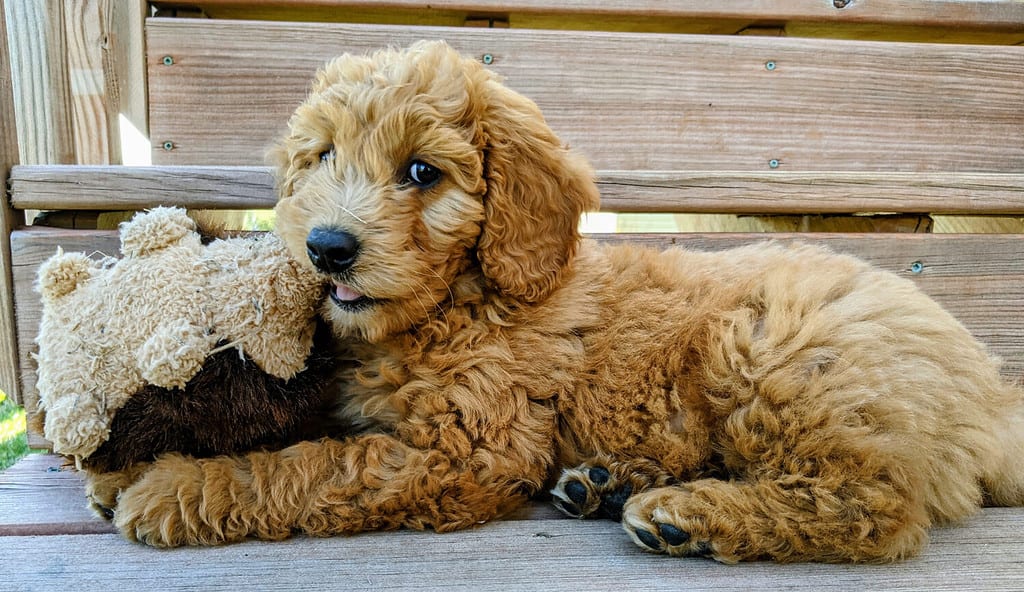
Goldendoodles are sought after.
©DBjorgo/Shutterstock.com
Goldendoodle Progression: Size Ranges
Since goldendoodles are mixed-breed dogs, there is no official size standard. Additionally, breeders produce a range of sizes by breeding golden retrievers with various sizes of poodles. To help give you an idea of what size your goldendoodle puppy may reach when fully grown, we’ll provide the AKC size standards for the golden retriever and the various sizes of poodles.
A male golden retriever should weigh 65-75 pounds, while a female golden retriever should weigh 55-65 pounds at maturity. A female standard poodle should weigh 40-50 pounds, while a male standard poodle should weigh 60-70 pounds at maturity. A miniature poodle should weigh 10-15 pounds. Finally, a toy poodle should weigh 4-6 pounds.
How Big Will My Goldendoodle Be When Fully Grown?
As you can see from the range of sizes listed above, the answer to how big your goldendoodle will be can vary dramatically. Many breeders market miniature, medium, and standard-sized goldendoodles. Miniatures roughly correlate to a dog that can weigh up to 25 pounds at maturity, medium sizes tend to range between 30-50 pounds, and “standard” or large goldendoodles often weigh 50-75 pounds.
Genetic diversity can range quite a bit with this mixed breed. Unless you’re bringing home a puppy from a breeder who can provide thorough lineage paperwork, you may not be able to predict what size your pup will grow to.
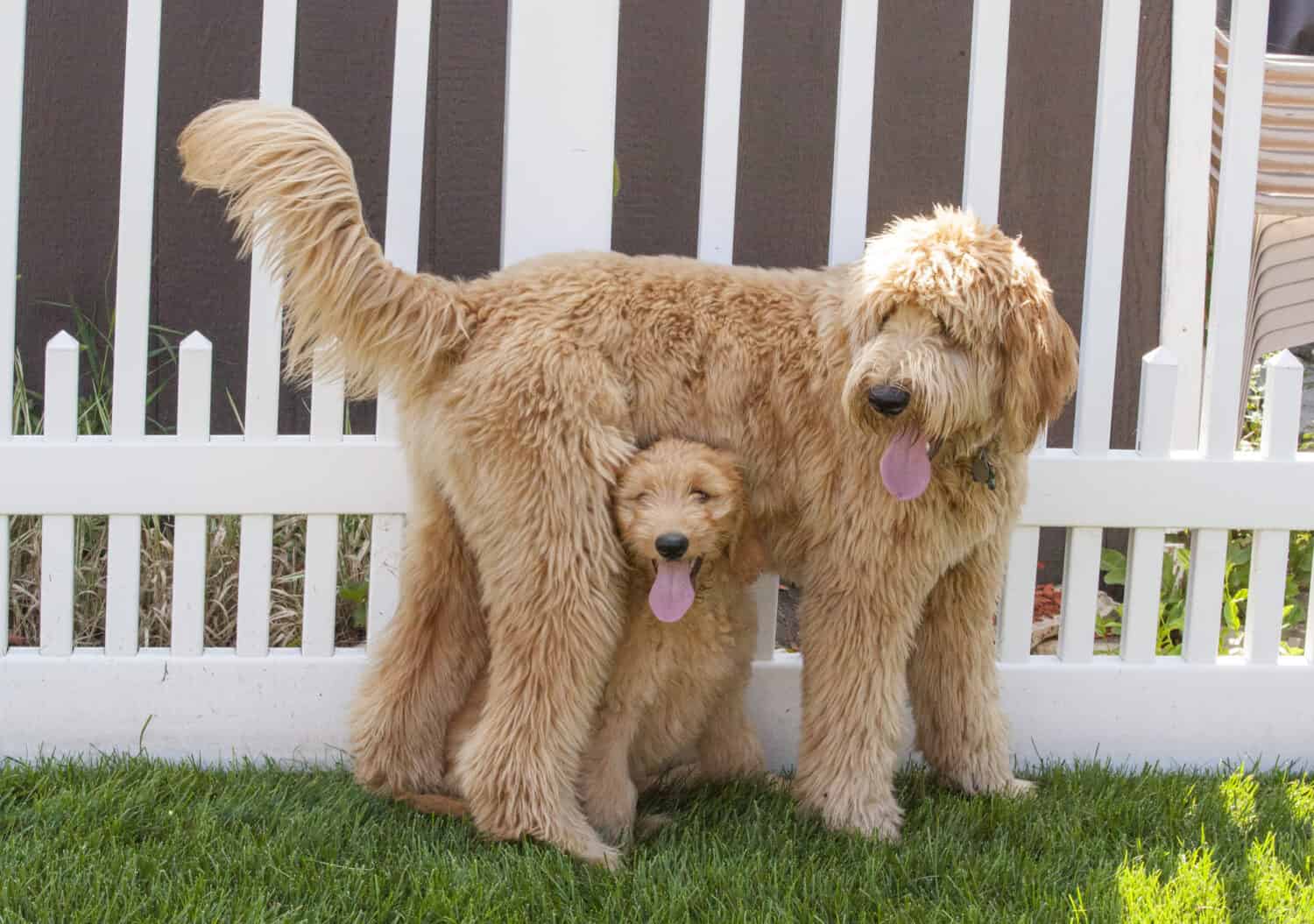
The size of your adult goldendoodle can vary. An adult, large-sized goldendoodle often weighs 50-75 pounds.
©Deanna Oliva Kelly/Shutterstock.com
Goldendoodle Progression: When Will My Goldendoodle Stop Growing?
Generally, toy and miniature breeds reach full maturity between 6-8 months of age. Medium breeds are usually fully grown at around 12 months old. Large breeds can grow until they’re 18-24 months old. So, this question will correlate to the size(s) of poodles your goldendoodle has in their lineage.
For example, if you have a goldendoodle with a standard poodle consistently in their lineage, you can expect that goldendoodle puppy to reach full physical maturity between 18-24 months.
By taking your goldendoodle puppy to regular checkups as they grow, your vet can ensure that your puppy is developing properly and reaching critical milestones.
When Should My Goldendoodle Be Spayed or Neutered?
Determining the best age to spay or neuter a dog is a complex question. You’ll need to take into account the breed and health of your specific dog. Spaying and neutering are associated with health benefits such as a reduced or eliminated risk of certain reproductive cancers. However, it can also be associated with many long-term health concerns. Several types of large breed dogs are at particularly heightened risks of developing joint and bone conditions from early spay and neutering.
Golden retrievers, in particular, face an increased risk of joint disorders and some cancers when altered too early. One large study of over 300 golden retrievers found that altering goldens before 1-year-old increased the occurrence of joint disorders 2-5 times that of intact dogs. The study also found an increased occurrence of several cancers when altered before 1 year.
Poodles were also included in this study. Male miniature poodles faced an increased occurrence of joint disorders when neutered under 1 year of age. In standard poodles, occurrences of canine lymphoma (LSA) rose from 4% in intact dogs to 27% in males neutered at or under 1 year old.
Given the health risks associated with early altering found in golden retrievers and some sizes of poodles, your vet may recommend waiting at least 1 year, if not more, before spaying or neutering a goldendoodle. Of course, since the goldendoodle is a mixed breed, they might not face the same risks as purebreds of either breed, but a conversation with an informed vet is still highly recommended.
Goldendoodle Progression: When Should My Goldendoodle Be Potty Trained?
You can begin potty training your goldendoodle puppy as soon as you bring them home. A crucial component to successfully teaching your puppy to use puppy pads or go outside is to understand how long they can hold their bowels and bladder.
Generally, the max amount of hours a puppy can hold correlates to how many months old they are. So, a 2-month-old puppy can typically only hold it for up to 2 hours before they need to eliminate it. As such, it’s essential to take them to the appropriate bathroom area before this maximum time is up. Overnight, you can use puppy pads near your goldendoodle’s sleeping area so you won’t have to get up throughout the night to take them outside. Please remember to provide enough space between their sleeping area and the puppy pads so you don’t force them to eliminate right next to where they sleep or eat.
If Accidents Happen
If your goldendoodle puppy has an accident inside, it’s important to never punish or scold them. Punishment only serves to damage your relationship. It doesn’t teach your puppy what you’d like them to do. It can also teach your puppy that you are someone to be wary and distrustful of. This can lead to a host of anxiety-related behaviors. It also may lead to your puppy hiding where they go to the bathroom inside as they won’t feel safe.
So, if you see them eliminating in an inappropriate spot, all you have to do is calmly take them to the puppy pad or outside. Give them lots of love and praise when they go. If they don’t, that’s also fine and you can try again later. You’ll also probably need to take them out more frequently or replace their puppy pads more often to increase success.
When Should My Goldendoodle Stop Eating Puppy Food?
You’ll need to feed your goldendoodle puppy food until they reach full skeletal maturity. So, this answer will depend on what size goldendoodle you have. Smaller-sized goldendoodles can transition to adult food around 7-9 months, while larger sizes should transition between 12-14 months old.
If you switch your goldendoodle to adult food too early, you can negatively impact their development, especially their joints, and bones. So, if you’re unsure of what size your goldendoodle puppy will likely reach maturity, make sure to consult with your vet.

When you’ll need to transition your goldendoodle puppy to adult food will depend on what size range they’ll reach maturity. A miniature goldendoodle, for example, can start eating adult food at 7-9 months old.
©sierraclark9/Shutterstock.com
Goldendoodle Progression: When Will My Goldendoodle Start Losing Teeth?
Your puppy will begin to lose their set of 28 primary, or deciduous, teeth at around 12 weeks old. At this point, their set of 42 adults, or permanent, teeth will begin erupting from their gums. By around 6-7 months of age, all of their permanent teeth should have grown in.
Your puppy will be teething during this time to soothe the discomfort of this process. It’s important to provide them will lots of safe chewing options In addition to providing chew toys of various textures, frozen carrots are also a great option to help soothe your puppy’s sore gums.
You may need to gate off certain areas of the house to prevent chewing unsafe or valuable items. You may also need to create puppy-proof storage solutions to keep items out of reach of your pup’s teeth.
If you find them chewing something inappropriate, please refrain from scolding or snatching the item away. Instead, offer the puppy something of equal or better value than what they’re chewing on. By trading rather than just taking, you’re teaching your puppy that you are safe to give items they are chewing on to. Only taking items away from your goldendoodle can create habitual resource-guarding behaviors and damage your relationship.
When Should I Start Training My Goldendoodle?
You can begin teaching your goldendoodle puppy a small set of easy-to-understand cues as early as 8 weeks old. At this age, these training sessions should only last a couple of minutes. The concepts should be broken down into easily processed segments. Throughout your goldendoodle’s life, training should be fun, and rewarding, and increase the bond of your relationship. Innately rewarding education and positive reinforcement (which is the use of offering rewards to increase desired behaviors) should be your go-to methods of teaching your pup.
In addition to teaching your pup cues that are essential for navigating a human-oriented world, it’s also essential to prioritize developing a secure attachment bond with your puppy. The importance of training is often framed as the most essential component of raising a puppy.
However, modern canine behaviorists understand that, just like with raising a human baby, developing a secure attachment bond is crucial to facilitating the growth of an individual who feels safe, secure, confident, and curious about the world. Behavioral symptoms often arise in dogs who don’t feel safe in their environment and don’t have caregivers who they can turn to as a secure, safe base of support.
Goldendoodle Progression: What Cues Should I Teach My Goldendoodle First?
Teaching a strong recall and a “drop it” cue are two essentials when raising a goldendoodle pup. Since your puppy is part retriever, they may love to pick up and carry around various items. Establishing a solid, reliable recall and teaching them to willingly drop items can help keep them safe.
You can teach recall with your pup by taking a couple of steps away and encouraging them to come to you. Offering treats, toys, play, and snuggles will strengthen your bond. This will also encourage your pup to want to come to you when called. Similarly, if you offer a scrumptious treat or game of tug whenever your pup drops an item for you, you’ll greatly increase the reliability of your goldendoodle dropping items when you ask.
To teach “drop it”, offer your pup a high-value treat or toy while having something else in their mouth. As soon as they open their mouth to drop the item to take the trade, calmly and gently say “drop it” to teach them this essential cue. After consistently saying “drop it” every time your puppy drops an item to accept a trade, you’ll be able to start using the phrase as a cue.
When Will My Goldendoodle Calm Down?
Folks often attribute golden retrievers with excitability and a long adolescent phase. These pups don’t tend to reach social maturity until they are 3-4 years old. Poodles tend to reach social maturity around 2-2.5 years old. So, you may see a decrease in puppy energy in your goldendoodle 2-4 years of age.
It’s crucial to understand that your goldendoodle may not be able to feel calm and content if you don’t meet their species and breed-specific needs. As a species, dogs (much like us) need social companionship, safety, freedom from oppression, play, mental and physical enrichment, freedom of movement, choice, comfortable shelter, and restorative sleep (for adults, 12-14 hours a day). If your dog is lacking in any of these crucial categories, you may find that they exhibit hyperactivity, restlessness, and anxiousness.
In particular, your goldendoodle may have an affinity for water-based enrichment and retrieving items. If your pup seems to be having difficulty settling or feeling calm, it’s always a good idea to contact a force and fear-free behaviorist or veterinary behaviorist.

©iStock.com/Guy Banville
Your goldendoodle may enjoy water-based enrichment. Proper, consistent enrichment will help your dog feel calm and content.
Goldendoodle Progression: Common Health Issues Your Goldendoodle Might Experience
Since your dog is a mixed breed, it will tend to face fewer risks of inherited illness compared to purebred dogs. However, the rapid rise in popularity of goldendoodles has led to rampant backyard breeding of inbred lines as people churn out these dogs for profit. Additionally, both golden retrievers and poodles share some of the same increased risks of certain inherited conditions. As such, your goldendoodle may be at increased risk of the following conditions that affect both breeds:
- Hip dysplasia
- Gastric dilation-volvulus (bloat)
- Hypothyroidism
If you notice clinical signs or sudden behavioral changes in your goldendoodle, it’s important to set up a vet check.
Picture of a Goldendoodle Puppy
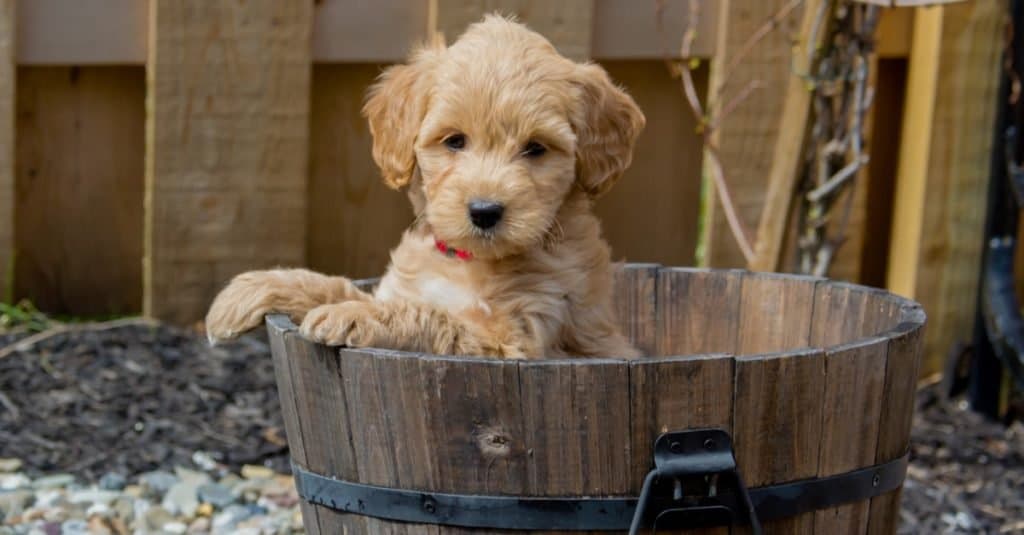
©Marcello Sgarlato/Shutterstock.com
An adorable goldendoodle puppy.
Picture of a Goldendoodle at 6 Months
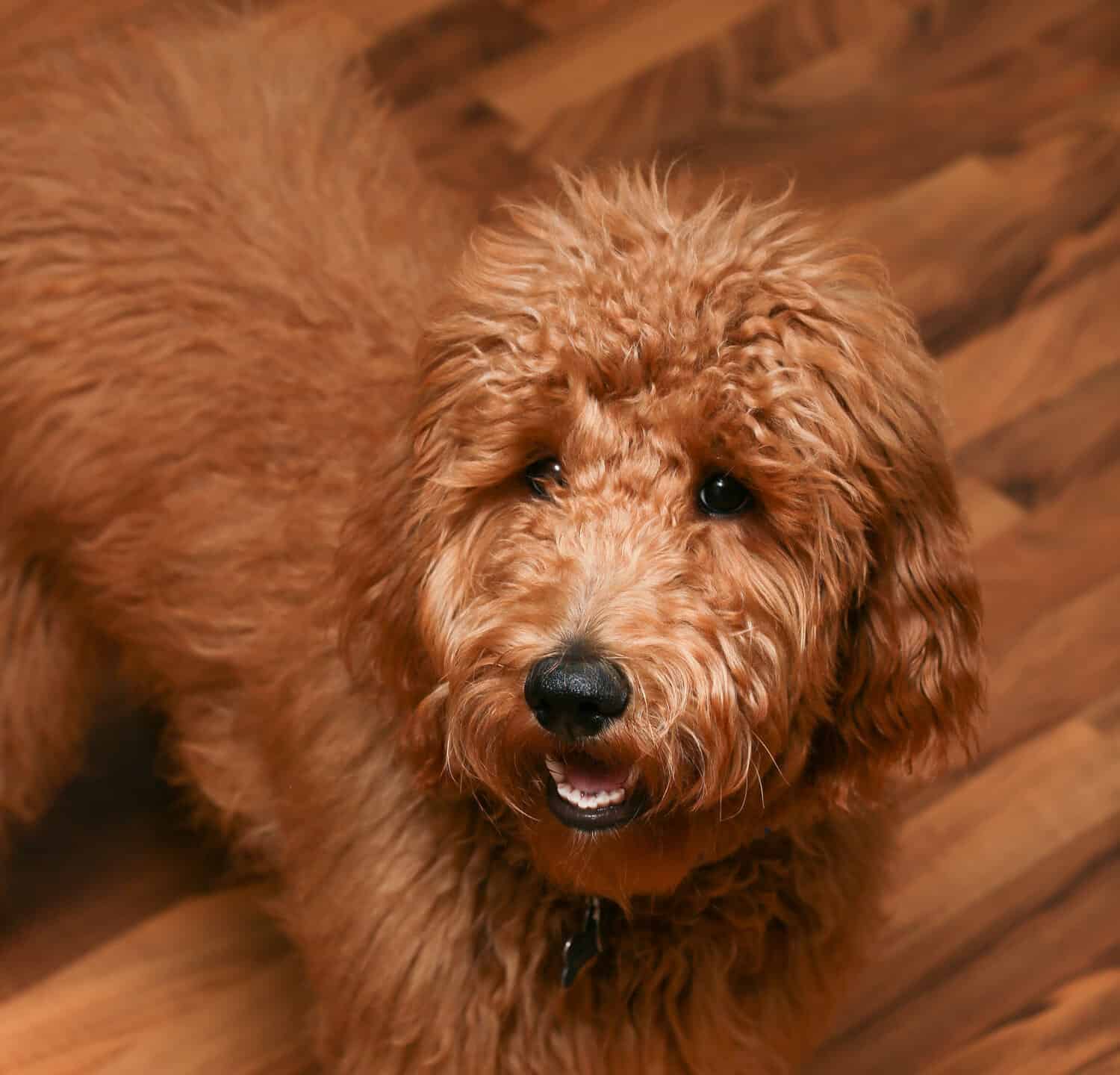
A friendly 6-month-old goldendoodle puppy.
©JennyandCasey/Shutterstock.com
Picture of a Fully Grown Goldendoodle
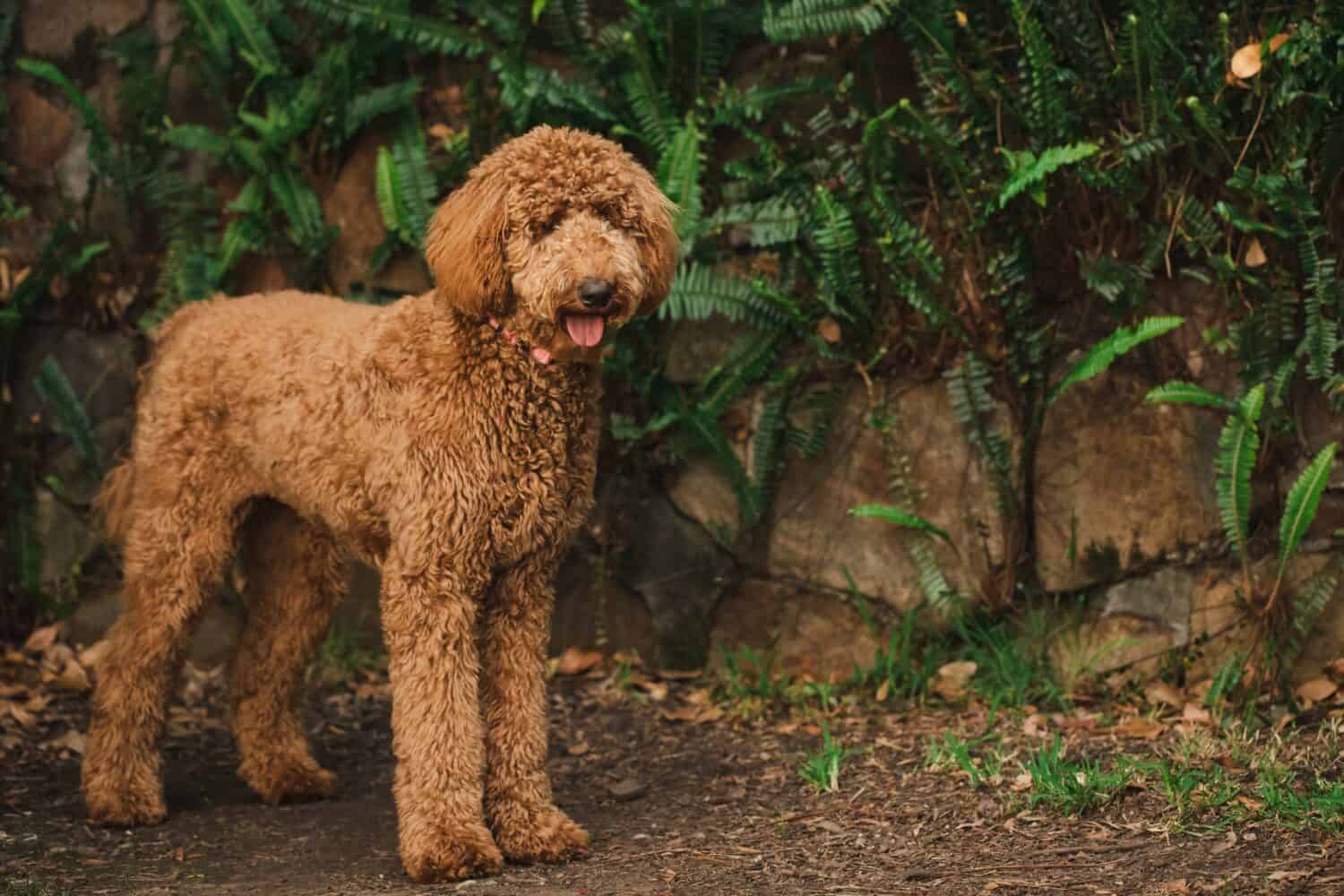
A lovely goldendoodle in a fern-covered environment.
©caseyjadew/Shutterstock.com
The photo featured at the top of this post is © SoySendra/Shutterstock.com
Ready to discover the top 10 cutest dog breeds in the entire world?
How about the fastest dogs, the largest dogs and those that are -- quite frankly -- just the kindest dogs on the planet? Each day, AZ Animals sends out lists just like this to our thousands of email subscribers. And the best part? It's FREE. Join today by entering your email below.
Thank you for reading! Have some feedback for us? Contact the AZ Animals editorial team.







